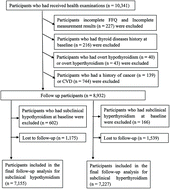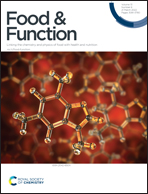Ultra-processed food consumption and the risk of subclinical thyroid dysfunction: a prospective cohort study
Abstract
Background: prospective cohort studies linking ultra-processed foods (UPF) and subclinical thyroid dysfunction (SCTD) are limited, especially in Chinese adults. Objective: we designed a large-scale cohort study to examine whether UPF consumption is a risk factor for SCTD in adults. Methods: this prospective cohort study investigated 8732 participants (mean age: 44.7 ± 10.7 years; 53.3% men). UPF consumption was measured at the baseline using a validated food frequency questionnaire and classified according to the NOVA classification system. SCTD was characterized by abnormal serum thyroid-stimulating hormone levels and normal free thyroxine. Cox proportional hazards regression models were used to examine the association of UPF consumption with the risk of various types of SCTD. Results: during the follow-up period, the incidence rate of subclinical hypothyroidism was 8.3/1000 person-years and that of subclinical hyperthyroidism was 7.0/1000 person-years. After adjusting the potential confounding factors, the multivariable hazard ratios (HRs) (95% confidence intervals) across increasing tertiles of energy-adjusted UPF consumption for subclinical hypothyroidism were 1.00 (reference), 0.82 (0.57, 1.18) and 0.87 (0.60, 1.27) (P for trend = 0.47) and for subclinical hyperthyroidism were 1.00 (reference), 1.09 (0.71, 1.68) and 1.69 (1.12, 2.56) (P for trend = 0.01). Per one standard deviation (58.0 g per 1000 kcal per day) increase in ultra-processed food consumption a 14% increase in risk of subclinical hyperthyroidism was observed (HR = 1.14; 95% CI: 1.00, 1.30; P = 0.04). Further sensitivity analysis showed that the fully adjusted HRs (95% CIs) of subclinical hyperthyroidism across tertiles of the proportion of UPF in weight for subclinical hyperthyroidism were 1.00 (reference), 1.06 (0.69, 1.63) and 1.63 (1.09, 2.46) (P for trend = 0.01). Conclusions: this population-based prospective cohort study has firstly demonstrated that higher UPF consumption was associated with higher risk of subclinical hyperthyroidism in adults. The UMIN clinical trial registry number is UMIN000027174 (https://upload.umin.ac.jp/cgi-open-bin/ctr_e/ctr_view.cgi?recptno=R000031137).



 Please wait while we load your content...
Please wait while we load your content...